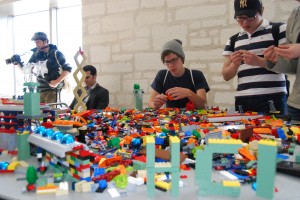My comic is on Gizmodo, Make Magazine Blog, Lifehacker, and many more sites. Thank you, everyone!
Author: jodyc
Arduino Comic on Boing Boing
Thank you Boing Boing and Cory Doctorow for linking to my comic! Also thanks to those who made comments, they are (and will continue to be) helpful in making revisions.
Comic on Arduino Site
Thanks Tom Igoe for blogging about my Introduction to Arduino Comic!
Introduction to Arduino
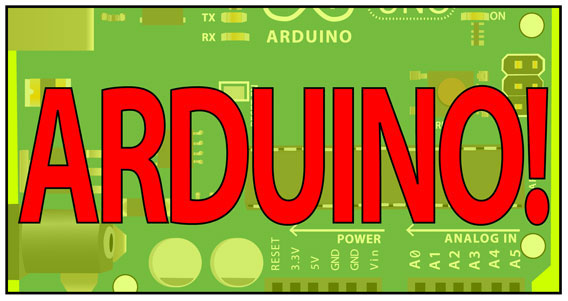
Click here for my version 1.0 of Introduction to Arduino comic as a PDF. For a slightly revised version, click here (updated to software version 1.05).
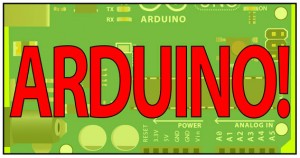
The Arduino Playground has a version of the PDF I prepared with blank word balloons and text fields, and also my script with notes if you want to translate it.http://arduino.cc/playground/Main/ArduinoComic. They also have versions in other languages. If you translate it, please let me know.
Here are links to some of the translations, there’s more on the Arduino site. Thanks everyone!
- in Spanish, by Jose Manuel Escuder
- in Catalan, by Antoni Ubieto
- in Dutch, by Johan Korten
- in German, by Thorben Weber
- in Greek, by Anna Maragkoudaki
- in Polish, by Tomek Maslany
- in Portuguese, by Claudio Miklos
- in Arabic, by Ahmad Y. Saleh
- in Korean, by kocoafab
ITP Camp 2
It’s been a couple of weeks since the end of ITP camp, and I have to say, it was memorable once again. The laser cutter! I spent a lot of time cutting and etching fabric, glass and wood. I would like to have one of these at home, though I might never go outside again.
There were many great sessions- Jeff Feddersen’s Making Electricity stood out, as did all of Tom Igoe’s pcomp sessions. I learned a bit more about Processing with Matt Parker and Andres Colubri, also integrating Processing with 3D software Rhino, as well as a framework for App development, Cinder. And Jitter from Gabe Barcia-Colombo. I am looking forward to working in Processing for Android with Arduino. Kate Hartman’s wearable session was great too. This year I gave a session on Instructional Comics. There was plenty more, I unfortunately had to leave early for family stuff. But I will probably be back, to see old and new friends, as well as catch up on some new technology.
I now have my ethernet shield up and running with my Arduino, turning servo motors from a webpage. More to come soon, with pictures.
ITP Summer Camp 2011
After having a great time at ITP Summer Camp last year, I decided to attend again. In the few days since it started, I have learned about hacking the Kinect from Dan O’Sullivan, made pop-up books with Marianne Petit, heard Clay Shirky discuss social media and the Arab Spring, listened to Danny Rozin talk about his mirror pieces. Also, eat some camp-style hamburgers. I also participated in 1 in 1, one project in one day, start to finish with documentation. Fun! More details later.
Art Access and Decay
I am in a group show at Subliminal Projects in LA called Art Access and Decay. The exhibition features work created in New York in the late 70’s and 80’s. Check it out here. I am showing cardboard jewelry.
SXSW: Day Three
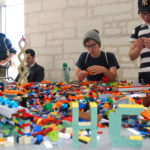
Panels! First The Politics of HTML 5. Unfortunately I only saw about half of this panel. The panelists discussed the problems of setting the specs for the HTML 5 standard and navigating the interests of stakeholders who sometimes have opposing objectives- the “priorities of the various constituents†are not the same. John Foliot of Stanford pointed out that a large percentage of the open bugs and issues in the standard currently have to do with accessibility. “There is tension between what a working group can do and a federal agency can do.â€
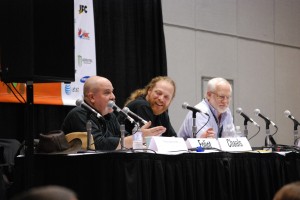
Urban Technology on the Dark Side looked at the relationship of cities to technology, focusing partially on military and governmental surveillance. It also showed how activists, artists and architects have subverted techniques of surveillance and partition to their own ends. Artist and geographer Trevor Paglen’s long-range photographs and Project Cybersyn, a project in real-time computing used as an economic model during the Salvador Allende government in Chile were shown.
At Big in Japan: Outreaching to a Unique Market, panelists discussed specific cases that succeeded in establishing brands in the Japanese market. Blogger Fumi Yamazaki explained how different generations use mobile devices, and pointed out that the commute of the average Japanese worker is about twice as long as an American’s and it is spent on a train (not driving) where they can use their devices. Ryan Holmes of Hoot Suite commented that some of their success in Japan might be due to the cute mascot they had made into a stuffed animal. Information was shared about contributing to the relief effort in Japan.
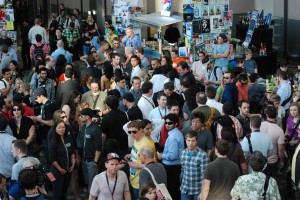
Founder of 4chan Christopher Poole discussed the importance of allowing users to remain anonymous in a site with user-generated content such as his image-based bulletin board. “The cost of failure is really high when you are using your real name.†His site favors “content over creator, creators squeezed together riffing back and forth. In 4chan, its not just the product but the process as well.â€Â In 4chan, none of the content is archived, it is dynamic and ephemeral. Poole also demoed Canvas, his new project which launched in beta earlier this year. Again it is user-generated, set up in a collaborative model, at this point all content is visual. This time users must set up an account, for now through Facebook, though they may remain anonymous. It offers users simple tools “to level the playing field†to create and share images.
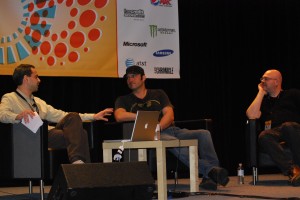
Of Fanboys & Fidelity – Adapting Comics For Broad Audiences: Filmmaker Robert Rodriguez, (who as an undergraduate at U T was a cartoonist and had a strip in the student newspaper), had long been a fan of Frank Miller’s series Sin City when he approached him about making the series into a film. He got Miller interested in working with him by shooting some scenes based on the graphic novel and flying to NY to show him. Miller was concerned about the script, so Rodriguez wrote it in a month based on the graphic novels (there is no screenplay credit in the movie, Rodriguez considers it an adaptation). “I made it very easy for himâ€.
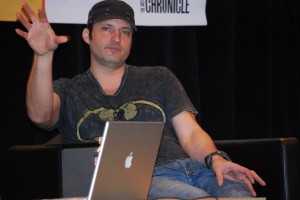
Greg Rucka, writer of the graphic novel Whiteout, discussed his experience in seeing his work turn into a movie. He did not write the script, he wrote 3 scenes based on character, not plot. Rucka expressed strong opinions on how the super hero genre is seen by Hollywood producers-“Fidelity to the character makes or breaks these movies. Big studios approach to super heroes is apologistâ€.
That’s it from me about panels for this year. Other SXSW news- this is the year of the group messaging app. GroupMe, Beluga and many more. The parties were a lot of fun, Lone Star beer everywhere, along with a big pile of carrot sticks.
